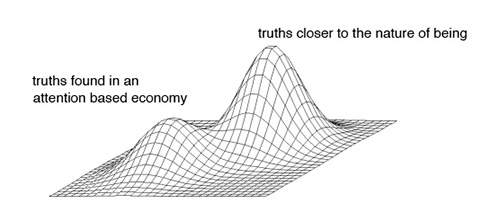These attention based spectacle-fueled image-objects are “a constellation of formal aesthetic
quotations, self-aware of (their) ... context and built to be shared and cited” (K) rather than the “essence of technology…the constellation, the stellar course of the
mystery”(M). This distinction, however potentially problematic in its dualism, presents two
modalities which should be considered with a great deal of importance. One modality is of
power and currency, the other is of beauty and truth. As Heidegger states, one modality
becomes "transfixed in the will to master it(self) as an instrument”(M) and fails to “hear in
what respect one exists in terms of ones essence”(M). While the other reaches toward the
essence of technology which “resides in a poetic dwelling near the truth of Being”(M).
Through the lens of Heidegger one could say that the relationship between the imageobject
and its components of physical, digital and ideological forms, and the modulation of
these components, is a means of ordering as a way of revealing. Heidegger states that
Enframing is the “calling out to unconceal the actual”(M) from which “the essence of all
history is determined”(M) and that this behavior is “truth setting itself to work” (N). He
continues to state that the essence of technology lies in its revealing and unconcealing of
the truth. And that “technology comes to presence in the realm where revealing and
unconcealment take place, where aletheia, truth, happens.”(M) What then are the truths that
may be revealed by this iterative, self-consuming behavior of society and what is the history
that it has defined? Often it is those individuals who are interested in power, not beauty, that
write our history.
It seems plausible that this iterative and genetic approach of image-object
documentation, mutation, and reproduction, would over time reorder the image-object and
reveal, or unconceal, a truth closer to the core of the post-internet condition and the nature
of being. However, when novelty itself becomes the goal of a creative system, the strategies
of aesthetic mutation become polluted with tropes and clichés. Rather than a swift evolution
into new unknown forms, this activity becomes a frantic flailing. This methodology treads
water, gasping for the air of truth in a sea of self-referential ironic gestures. If there is
sincerity within the work, it’s the sincere embrace of attention as currency, and a willingness
to never escape the isolated arena of the aesthetic object. This is an activity “so inextricably
linked with a variety of interpretations on Conceptual art doxa”(K), (the commonly held
beliefs and often unquestioned opinions) that it lacks a Logos (a ground, an argument, a
wider context), necessary to deliver it into Episteme (clear truth, certainty of knowledge).
This activity is a tool for the formation of an argument, which lacks both context for the
argument, and the argument itself.
